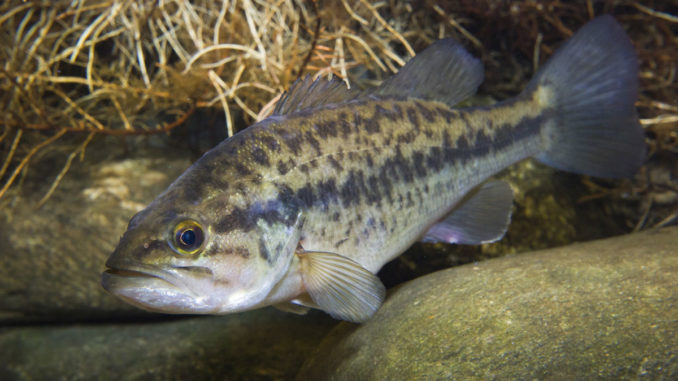
Moving water is important to August success
August is a tough month for bass fishermen; there’s no doubt about that. But it doesn’t have to be impossible, if you understand how to make current work in your favor.
Bass and other fish love current because it carries food into their living rooms. They love current because it usually carries water that’s better oxygenated and cooler than water that’s just sitting still, being heated by the sun. So find current, and you’ll find bass. You need to fish areas with the most current possible.
Current is a given when you’re fishing a river or in the upper reaches of a reservoir that’s being fed by water through the tailrace below an upstream dam. That kind of current is fairly easy to fish; you look for current breaks where fish can rest and not fight the flow. You’re looking for logjams and little eddy points, and in those cases, the more current you have, the better. If you are fishing in a river or the upper end of a lake and there’s no current, there’s not going to be any bite.
When you’re fishing on the main body of a lake or in a big tributary creek, current isn’t a given. It can be there, but you have to know it and have to know how important it is and how to approach it. Current on the main part of a lake is usually the product of water being released through a dam to make the hydroelectric power that runs everybody’s air conditioner.
You can usually see current by watching debris floating on the surface; when the leaves are cruising downstream, it’s a good bet that somebody is pulling or pushing water through a dam. And it’s a better bet that fish are going to respond by starting to feed. How you find and set up to fish current is important. Sometimes, the best current is around a bend in the channel or around an island in the middle of the lake that splits the flow. A key is to imagine how bass will set up with relation to the current to take advantage of it. Try to figure out where the current is headed and if there’s any bottom structure that could divert it: a stump, brush pile, log jam, big rock, a hump, even a contour line. With electronics like my Raymarine unit available these days, you can actually see these features and understand that fish will set up behind them, out of the current but ready to rush out and grab that unlucky shad, bream or white perch that is pushed past.
Bass this month are going to be the deepest they are all year. I’ve caught them in August as deep as 38 to 40 feet, but most of the good fish you’re going to catch are going to be 18 to 25 feet deep. Depending on the lake, I’m going to be fishing from halfway back in creeks out to the main lake. If I’m at Gaston, I’m going to be on the main lake, because the creeks are too shallow. At Buggs Island, High Rock or Wylie, you can fish from halfway back in creeks to the main lake and have enough depth. Berkley’s 25 Dredge is perfect for these kinds of depths. You can get it deeper, but it stays in that 23- to 24-foot strike zone for a very long time on every cast. Use chartreuse/blue, homer and the honey shad colors.
Finding them is one thing; getting them to bite is another. That’s often the hardest thing to do, because the extreme heat makes bass sluggish, and getting one to commit to hitting a crankbait, jig, spoon or Carolina rig is a task. This is when you need to be patient, and that’s a problem for most of us. We want to set up on a spot and throw 10 times and leave if we don’t get a bite, when it make take a lot more coaxing to get one to bite. But once you get one, you’ve got a chance to catch a big sack.
The annual ICAST show where fishing tackle manufacturers and dealers get together finished up a few days ago in Orlando, Fla. The companies I’m associated with brought out some new products that can definitely help anglers out in the heat of August.
Lew’s came out with a 9-foot, David Fritts signature crankbait rod. It’s 92-percent fiberglass, and it’s collapsible so it will fit in a rod box. It is a must-have if your fishing deep, main-lake structure this month. Because you can cast so much farther with the longer rod, you can add anywhere from 1 to 3 feet to the depth your crankbait will run, and when fish are down in that 18- to 25-foot range, that’s extremely important. And I love the fact that it’s just about as light as a 71/2-foot rod.
Berkley also came out with some new crankbaits, the 7.5 Square Bull, which is a square-billed bait that has a big body and will be a really good bait in the fall. Another is an 8.5 Dredge, a little 2-inch bait that will run down to 11 feet. It’s comparable to a Bandit 200, but it’s got a smaller profile. This will be a smallmouth and spotted bass killer.
Last is a 4.5 Digger; it should be called the “Tide Chaser,” because it will be a perfect tidal-water bait. It’s a 11/2-inch bait that will run 7 feet deep with a light rod. It’s similar to an old Bagley Killer B1. It will be a great bait to fish in August in the river section of lakes; it will fit in every tackle box. The hooks ride well behind the bait, so it’s pretty much weedless — and it’s got a lot of kick.




Be the first to comment